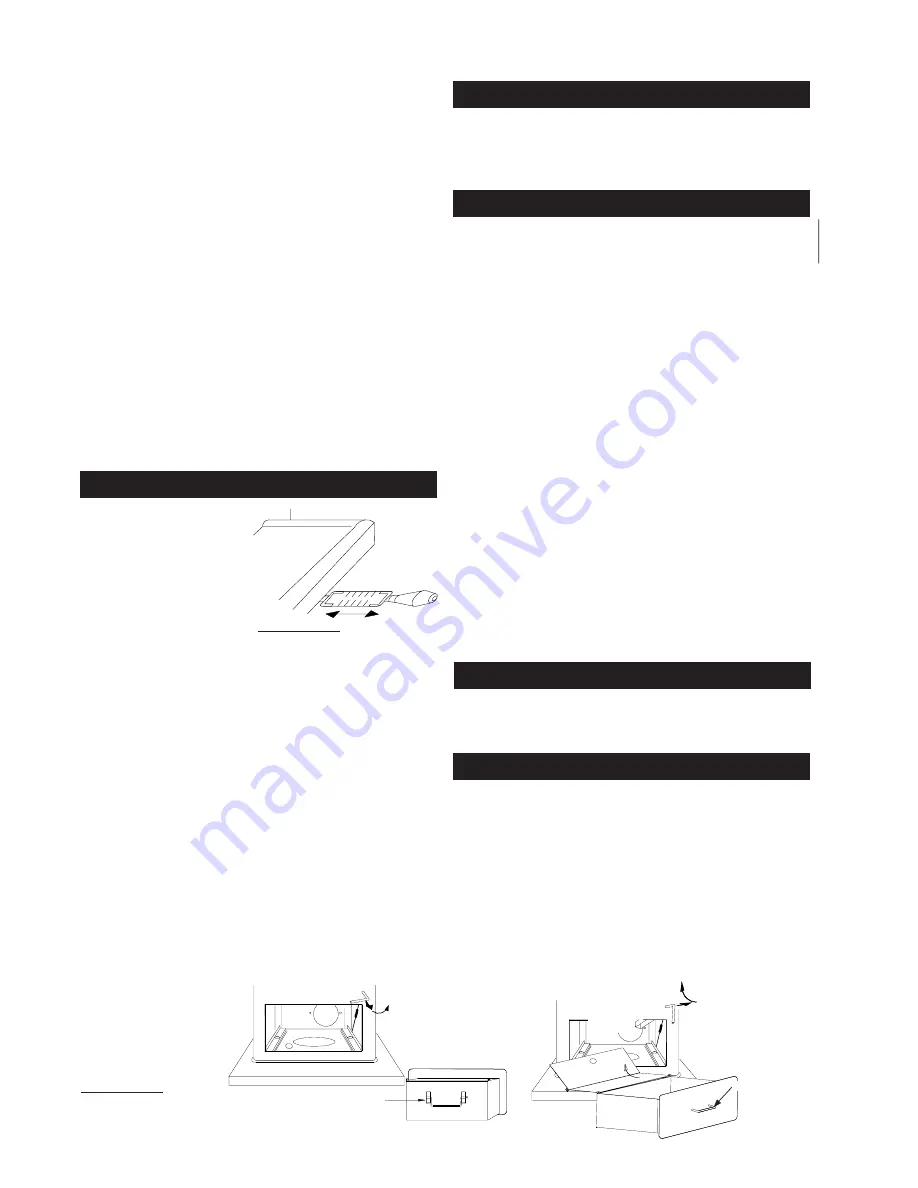
12
W415-0512 / B / 11.15.05
ASH WELL
COVER
ROTATE
TO CLOSE:
FOLDING
HANDLE
REAR
ROTATE
PULL AND
TO OPEN:
You can now add larger pieces of wood and operate the
stove normally. Once the stove/insert is entirely hot, it will
burn very efficiently with little smoke from the chimney. There
will be a bed of orange coals in the firebox and secondary
flames flickering just below the top firebrick. You can safely
fill the firebox with wood to the top of the door and will get
best burns if you keep the stove pipe temperatures be-
tween 250 degrees Fahrenheit (120 degrees Celsius) and
450 degrees Fahrenheit (270 degrees Celsius). A surface
thermometer will help regulate this.
Without a stove thermometer, you are working blindly
and have no idea of how the stove is operating! A stove
thermometer offers a guide to performance.
Can't get the fire going? Use more kindling and paper.
Assuming the chimney and vent are sized correctly and
there is sufficient combustion air, the lack of sufficiently dry
quantities of small kindling is the problem. Thumb size is
a good gauge for small kindling diameter.
Can't get heat out of the unit? One of two things may have
happened. The stove/insert door may have been closed
prematurely and the unit itself has not reached optimum
temperature. Reopen the door and/or draft control to re-
establish a brisk fire. The other problem may have been
wet wood. The typical symptom is sizzling wood and mois-
ture being driven from the wood.
Draft is the force which
moves air from the firebox up
through the chimney. The
amount of draft in your chim-
ney depends on the length
and diameter of chimney, lo-
cal geography, nearby ob-
structions and other factors.
Adjusting the draft control
regulates the temperature.
The draft can be adjusted from a low burn rate with the
handle in fully, to a fast burn rate with the handle fully out.
Inadequate draft may cause back-puffing into the room
through the stove/insert and chimney connector points and
may cause plugging of the chimney. Too much draft may
cause an excessive temperature in the stove, glowing red
stove parts or chimney connectors or an uncontrollable
burn which can lead to a chimney fire or permanent dam-
age to the unit.
Do not operate your stove/insert for longer than 30 min-
utes with the draft control on "HIGH" (fully open).
All homes with a solid fuel burning fireplace should have at
least one fire extinguisher in a central location known to all,
and at least one smoke detector in the room containing the
fireplace. If it sounds an alarm, correct the cause but do not
deactivate or relocate the smoke detector.
When loading the stove, ensure that the two upper fibre
baffles are not lifted up and off their ledge.
For maximum efficiency, when the stove is thoroughly hot,
load it fully to the top of the door opening and burn at a me-
dium low setting. Maximum heat for minium fuel (optimum
burn) occurs when the stove top temperature beneath the
trivet is between 500°F (260°C) and 600°F (315°C). The bricks
will be nearly all white and the glass mostly clear. The white-
ness of the bricks and the cleanness of the glass are good
indicators of your operating efficiency. Not enough heat is
produced when only one or two pieces of wood are burned or
the wood may not burn completely. A minimum of three pieces
are needed to encase a bed of coals that sustains the fire.
Loosely stacked wood burns quicker than a tightly packed
load. Wood burns in cycles rather than giving a steady output
of heat. It is best to plan these cycles around your household
routine so that only enough coals are left to start the next load.
In the evening, load your stove, at least, a half-hour before
bed to ensure a good fire, hot enough to close the draft con-
trol for an overnight burn. Burn only dry seasoned wood.
It produces more heat and less soot or creosote. Do not burn
ocean beach wood. Its salt content can produce a metal eat-
ing acid. When refueling open the door slowly to prevent
smoke spillage. Use a pair of long gloves (barbecue gloves)
when feeding the fire. Because these stoves burn at the front,
they are clean and efficient, but they are also very hot and
gloves are useful. Keep a small steel shovel nearby to use as
a poker and to remove ashes. Do not store the wood within 3
feet (1m) of the stove.
A flash fire is a small fire burned quickly when you don't need
much heat. After your kindling has "caught", load at least 3
pieces of wood, stacked loosely. Burn with the draft control
fully open or closed only slightly.
Load your larger pieces of wood compactly, packed close
enough to prevent the flames from penetrating it completely.
After approximately 30 minutes, depending on the size of the
load, close the draft control completely making sure that the
fire is not extinguished.
DO NOT OVERFIRE THE STOVE!
Overfiring can occur by:
a)
burning large amounts of smaller wood pieces such as
furniture scraps, skids or treated wood;
b)
vigorously burning large loads of wood with the draft con-
trol on "HIGH" (fully open) for long periods of time (one or
two hours).
*
NOTE: 1100C/1150 and
optional EPA Leg Models
ash pans are not equipped
with a cover or rear folding
handle.
FIGURE 31
PULL HANDLE
HIGH
LOW
1
2
3
4
5
FIGURE 30
ASH FENDER
ACHIEVING PROPER DRAFT
FIRE EXTINGUISHERS / SMOKE DETECTORS
FUEL LOADING AND BURN CYCLE
FLASH FIRE
EXTENDED FIRE
Содержание 1100C
Страница 19: ...19 W415 0512 B 11 15 05 NOTES...
Страница 20: ...20 W415 0512 B 11 15 05 NOTES...






































